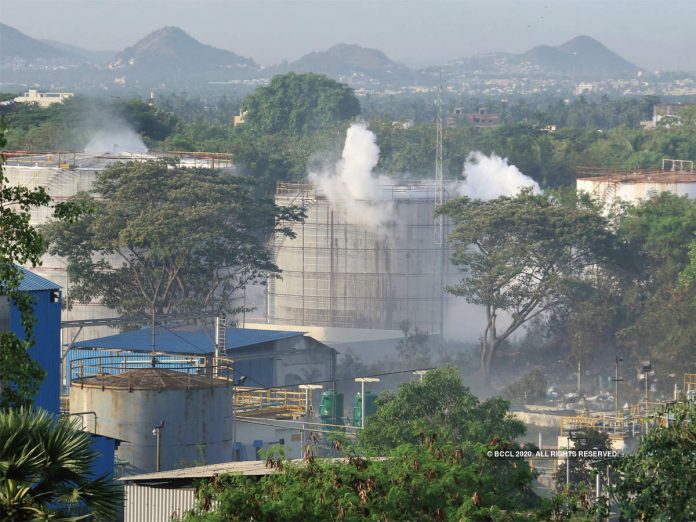This article is written by Mantul Bajpai, an associate with Crawford Bayley, a Mumbai based law firm in their dispute resolution team, and Kirti Kejriwal, from Amity University, Kolkata. In this article, the authors have discussed about the Vishakhapatnam Gas Leak Tragedy.
Table of Contents
Introduction
On the morning of May 7th, 2020, a major leak of Styrene gas occurred from a polymer plant near Visakhapatnam owned by LG Polymers India Private Limited (“Company”). The mishap claimed the lives of 11 people and affected thousands in the area. The chilling scenes at the place of disaster with affected people laying on roads, health care workers rushing to attend those affected and children being carried by their parents in their arms brought back grim memories of the 1984 Bhopal Gas Disaster. However, in comparison, the casualty of human lives from the Styrene gas leaked from the plant near Visakhapatnam is considerably lower.
The gas leak, as per the prima facie findings, is a result of failure by the Company to comply with the Manufacture, Storage and Import of Hazardous Chemical Rules, 1989 that requires the Company to maintain on-site and off-site emergency plans to ensure prevention of damage.
Steps by NGT
National green tribunal, Principal bench, New Delhi Suo-Moto took cognizance of the case and passed an interim order of constituting a fact finding committee which would be headed by the former Andhra Pradesh High Court Judge BS Reddy to inspect the site and submit its report to NGT within 10 days. The interim order dated 8th may 2020 directing the company to deposit a sum of 50 crores with the District Magistrate of Visakhapatnam.
NGT also said that the Leakage of the hazardous gas at a large scale adversely affected public health and environment clearly attracts the principle of Strict Liability against the company engaged in hazardous or inherently dangerous industry.
NGT interim order was a step backward because by explicitly using the words strict liability it’s not only provided the company to build defense by showing that there was no negligence on their part but has acted ultra vires section 17 of the NGT act 2010 which directs NGT to apply the principle of no fault even in cases of accident.[i]
If the principle of strict liability is applied it provides room for ample of exceptions in the present case, there are various theories about the leak’s cause, including mishandling of valve controls, a chemical reaction as a result of operators being unable to transport the gas due to the lockdown, auto-polymerization and vaporization due to stagnation, and changes in temperature inside the tank.
However the absolute liability does not provide for any of such exceptions.
The principle which is also involved is Polluter Pays Principle and Strict Liability versus Absolute Liability.

Polluter Pays Principle
Polluter Pays Principle is a well-recognized and much celebrated environmental law principle. The rationale behind the principle is fairly simple and places the responsibility of paying the damages to the persons who ought to pay it and also who have the ability to pay it. The principle implies that he/ she who damages the environment should bear the cost of rectifying that damage. The principle has played an important part in mitigation of environmental degradation.
The Polluter Pays Principle was first adopted at international level in the 1972 Organization for Economic Corporation and Development Council Recommendation on Guiding Principles concerning the International Aspects of Environmental Policies “OECD Principles”. One year later, the European Community followed the example of the OECD Principles from 1972 by adopting and implementing the first Environment Action Programme. Since 1987, the Polluter Pays Principle has been part of European Laws. It is included in Article 174 of the European Union Treaty, 1997. The Rio Declaration adopted in 1992 also recognizes the polluter pay principle. Principle 16 of the Rio Declaration reads as follows:
“National authorities should endeavour to promote the internalization of environmental costs and the use of economic instruments, taking into account the approach that the polluter should, in principle, bear the cost of pollution, with due regard to the public interest and without distorting international trade and investment.”
Since its introduction in 1972, the Polluter Pays Principle in the present time, has been given a much broader sense and therefore, not only covering pollution prevention and control measures but also covering liability such as costs for the clean-up of damage to the environment.
The ‘polluter pays principle’ was for the first time explicitly applied and defined in the case of Indian Council for Enviro Legal Action vs. Union of India. In this case, five chemical industries were producing H Acid. An azo dye and untreated toxic sludge were discharged into the open compound which, in due course of time, flowed through a canal across the entire area and the rainwater washed the sludge deep into the bowels of the earth. It caused pollution of river water and underground water up to 70 feet below the ground within a radius of seven miles of the village Bicchari in the Udaipur district of Rajasthan. It further left the fields nearby infertile, as a result of which residents had to migrate out of the village. The Supreme Court in its judgment declare that the redemption of the damaged environment is a part of the process of sustainable development and as such polluter is liable to pay the cost of the individual sufferers as well as the cost for reversing the damaged ecology.
Vellore Citizens Welfare Forum vs. Union of India was a public interest petition under Article 32 of the Constitution of India filed by the Vellore Citizens Welfare Forum against pollution which was being caused by the massive discharge of untreated effluent by the tanneries and similar industries in Tamil Nadu. The Petitioners, in the present matter alleged that tanneries discharge untreated effluent into agricultural fields, road-sides, waterways and open lands which ultimately reaches into river Palar, which is the main source of water for its residents. The pollution of water has risen to such a distressing point where drinking water is not available for the residents. The Apex Court held that polluting tanneries were liable to pay for the past pollution generated by them, which resulted in environmental degradation and suffering to the residents of the area. In this decision, two noteworthy principles, namely, the “Polluter Pays” and the “Precautionary” principles were further entrenched into the environmental laws in India.
In December, 1985, leakage of oleum gas from one of the units of Shriram Foods and Fertilisers Industries in Delhi, belonging to Delhi Cloth Mill Ltd resulted in the death of one advocate practising in the Tis Hazari Court and affecting several others. A writ petition under Article 32 of the Constitution was brought by way of Public Interest Litigation in the matter of M.C. Mehta and Anr. vs. Union of India. The Supreme Court, in its decision held that it was not bound to follow the 19th century rule of English Law as laid down in the case of Ryland v. Fletcher, and it evolved a rule which is suitable to prevail in the of social and economic India of the present times. It was for the first time, the Hon’ble Supreme Court in its decision laid down the rule of absolute liability where the Hon’ble Apex Court maximised the limit of rule of Ryland vs. Fletcher decided by the House of Lords. Supreme Court evolved a new rule creating absolute liability for harm caused by dangerous substance. The following statement of Bhagwati, C.J. which laid down the new principle may be noted:
“We are of the view that an enterprise, which is engaged in hazardous or inherently dangerous industry which poses a potential threat to the health and safety of the persons working in the factory and residing in the surrounding areas owes an absolute and non-delegatable duty to the community to ensure that no harm results to anyone on account of hazardous or inherently dangerous activity which it has undertaken. The enterprise must be held to be under an obligation to provide that the hazardous or inherently dangerous activity in which it is engaged must be conducted with the highest standards of safety and if any harm results on account of such activity the enterprise must be absolutely liable to compensate for such harm and it should be no answer to enterprise to say that it has taken all reasonable care and that the harm occurred without any negligence on its part.”
Absolute Liability vs. Strict Liability
From the above, it is evident that the principle of strict liability laid down by the House of Lords in the matter of Ryland v. Fletcher has evolved as far as the Indian jurisprudence is concerned. The rule of absolute liability as laid down by the Supreme Court in the matter of M.C. Mehta and Anr. vs. Union of India applies the principal of no-fault even in cases of accident in contrast to the strict liability principle which applies without any limitation or exception. In a highly developing economy like India where the hazardous or inherently dangerous industries are necessary to carry out development programme, it was important to modify the rules as per the present requirements.
Following are certain differences between the principles of absolute liability and strict liability:
- Whereas principle of strict liability allows exceptions if the liability has been accrued by an Act of God, act of third party etc., absolute liability offers no exception to the industries involved in hazardous activities and are liable for the damage so triggered notwithstanding adherence to the highest safety norms.
- Under absolute liability, the extent of damages depends on the magnitude and financial capability of the institute, however, under strict liability, compensation is payable as per the nature and quantum of damages caused.
- Under the doctrine of absolute liability, the element of escape is not essential. In other words, rule of absolute liability shall be applicable to those injured within the premise and person outside the premise, however, the same is not the case under the doctrine of strict liability.
NGT’s Interim Order: A Step Backward
In the matter of M.C. Mehta vs. Union of India, the Hon’ble Supreme Court after arriving at a conclusion that the principle of strict liability is woefully inadequate to protect citizens’ rights in an industrialised economy like India, formulated the principle of absolute liability. However, the Interim Order passed by the NGT directed the Company to deposit an amount of Rs. 50 crore as immediate compensation, by using the words “strict liability” has not only presented an opportunity to the Company to build its defence by showing that there was no negligence on their part but has acted ultra vires Section 17 of the National Green Tribunal Act, 2010 which directs the NGT to apply the principal of no-fault even in cases of accident.
Laws governing the chemical disaster in india[ii]
Before the Bhopal Gas tragedy only IPC sections were there to protect the chemical disaster.
Later we had the Environmental Protection Act of 1986 which is an umbrella legislation which provides coordination between the central and state authorities. The Act provides for the protection and improvement of the environment and speedy response to the situation threatening the environment.
The Act gives power to the Central Government to take measures for the protection of the Environment setting up standards for emissions and discharge of pollution, location of industries, management of hazardous waste, protection of Public Health.
Then by 1989 The Hazardous Waste Management, handling Rules for Management, Handling, Storing and Transportation of hazardous waste.
The Public Liability Insurance Act 1991 which was enacted to provide relief to the persons affected by the handling of hazardous.
The National Green Tribunal Act 2010 constituted the National green tribunal which would provide speedy and expeditious disposal of cases relating to environment and conservation of forest.
Despite all these acts India could not battle the environmental issues and management of hazardous waste.
Things unlearnt from Bhopal gas leak tragedy
This gas leak case showed that we have unlearned from the Bhopal Gas tragedy and now it is high time to learn from our mistakes and make strict regulatory bodies and provide us with a framework that would protect our environment and lives of people.
Reports suggest that the incident was similar to the Bhopal gas leak case, incidents differ intensities and unlike the UCC and LG did not know in advance the toxic gas could leak. The nature and the dealing of the substance by the companies were similar so it is inferred that the principle of absolute liability could also be applied here.
The prima facie findings shows the failure of the company to comply with Manufacture, Storage and Import of hazardous chemical rules, 1989. These rules required the company to maintain onsite and offsite emergency plans for prevention of damage.
Recent developments
Petition filed in Supreme Court[iii]
LG moved Supreme Court against the NGT order but Supreme Court refused to interfere with the order of NGT.
Andhra Pradesh High Court[iv]
The AP HC ordered the seizure of the premises of the Plant and barred entry except the committees appointed by the State Government.
The Court in its order of May 22 gave the directions that the directors cannot leave the country without prior permission of the Court and their surrendered passports shall not be released without permission. The court further directed that property including mobile, immobile, machinery of the company shall not be shifted without the leave of the court.
The court sought replies from State and Central Government before May 26 and the matter was posted for hearing on May 28.
Conclusions and suggestions
By providing ease of doing business and relaxing restrictions to promote industrial activity at the cost of environment and ecosystem are diluting the Environmental Laws and did away with the Labor Laws which were designed to protect the Rights of workers.
The Government of India should undertake efforts to prosecute the people responsible for the tragedy. Generally, in such cases, the people from the Indian company will be tried but due to technicalities in the law, the parent company will be absolved from any liability.
And all the more important that the NGT should have invoked the principle of absolute liability.
References
[i] https://m.thewire.in/article/rights/vizag-gas-leak-ngt-strict-absolute-liability/amp visited on 5th June, 2020.
[ii] https://www.drishtiias.com/daily-updates/daily-news-analysis/vizag-gas-leak visited on 6th June, 2020.
[iii] https://www.thehindu.com/news/national/ap-gas-leak-supreme-court-declines-to-interfere-with-ngt-order/article31627889.ece visited on 6th June, 2020.
[iv] https://zeenews.india.com/india/visakhapatnam-gas-leak-case-andhra-high-court-orders-seizure-of-lg-polymers-plant-2286049.html visited on 7th June,2020
LawSikho has created a telegram group for exchanging legal knowledge, referrals and various opportunities. You can click on this link and join:
 Serato DJ Crack 2025Serato DJ PRO Crack
Serato DJ Crack 2025Serato DJ PRO Crack










 Allow notifications
Allow notifications



